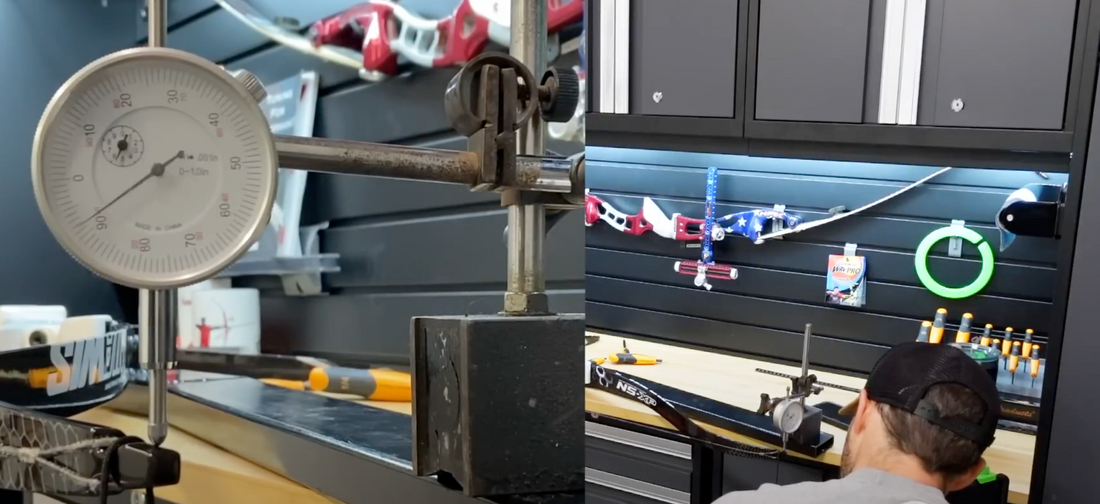
Torsional Rigidity Testing of Recurve Limbs
Share
Analyzing Stability, Forgiveness, and Performance
Introduction
In archery, limb stability plays a critical role in shot consistency and forgiveness. A key factor in this stability is torsional rigidity—the resistance of limbs to twisting under load. Manufacturers often suggest that higher torsional stiffness leads to more forgiving shots, reducing the impact of minor shooter errors. However, quantifying this claim is difficult without controlled testing.
To address this, I built a custom apparatus designed to measure torsional deflection in recurve limbs. This test applies a uniform weight to each limb tip while using a dial indicator to record deflection. The goal is to determine how different limb models compare in stiffness and whether trends in modern limb design are shifting toward greater resistance to twisting.
For this test, I examined four limb sets from Hoyt and Win&Win, all in 42# long configurations:
- Win&Win NS-XP Foam
- Win&Win MXT-XP Wood
- Win&Win MXT-XP Foam
- Hoyt Axia Foam
All data, including previous limb tests, will be available in the data repository on KaminskiArchery.com.
Testing Methodology
Apparatus Setup
The testing rig consisted of:
- ATF Riser with consistent tiller bolt positions
- Standardized brace height of 8 ⅞" (22.5 cm)
- 2-lb weight applied to limb tips
- Dial indicator preloaded for accuracy
- Three measurements per limb to ensure repeatability
The bottom tiller bolt remained unchanged across tests, while the top tiller was adjusted to maintain a neutral tiller setting before each measurement. This ensured uniform stress distribution across all limbs tested.
Results and Analysis
Raw Deflection Data (Measured in Thousandths of an Inch)
|
Limb Model |
Deflection Test 1 |
Test 2 |
Test 3 |
Average Deflection |
|
W&W NS-XP Foam |
110 |
110 |
110 |
110.0 |
|
W&W MXT-XP Wood |
101 |
101 |
100 |
100.7 |
|
W&W MXT-XP Foam |
104 |
104 |
104 |
104.0 |
|
Hoyt Axia Foam |
122 |
121 |
121 |
121.3 |
Key Observations:
- Win&Win MXT-XP Wood limbs exhibited the highest torsional stiffness (100.7 thousandths of an inch deflection).
- Hoyt Axia Foam limbs showed the most deflection (121.3), indicating lower torsional resistance compared to the Win&Win models.
- Both MXT-XP models (Wood & Foam) were stiffer than the NS-XP limbs, suggesting that Win&Win has optimized rigidity in their latest limb lineup.
- Compared to previous tests, all four limb models demonstrated increased stiffness, suggesting a shift in industry trends.
Industry Trends: Increased Torsional Stiffness
Comparing these results to previous limb testing data, it’s clear that limb manufacturers are actively increasing torsional stiffness over time.
In earlier tests:
- Hoyt Velos limbs measured ~115 thousandths of an inch, making them among the most rigid available at the time.
- The Win&Win limbs from that period averaged ~175-180 thousandths, significantly more flexible than today’s models.
With the MXT-XP limbs now exceeding Hoyt’s past Velos numbers, Win&Win appears to be aggressively refining their limb construction for increased stability and potential shot forgiveness.
Does Increased Torsional Stiffness Improve Forgiveness?
While it’s widely accepted that stiffer limbs are more resistant to form inconsistencies, empirical validation is still needed. Future testing will focus on accuracy consistency under simulated user error conditions, measuring group dispersion with different limb stiffness levels.
Conclusion & Next Steps
This test demonstrates significant advancements in limb rigidity, with Win&Win surpassing Hoyt’s previous high-water marks. While increased stiffness may contribute to greater forgiveness, further testing is needed to directly correlate these findings with on-target results.
Upcoming Tests:
- Accuracy dispersion testing across different stiffness levels
- Vibration & damping analysis post-shot
- Long-term durability testing of modern limb materials
For full access to the dataset and ongoing analysis, visit KaminskiArchery.com.
Support This Research
Independent testing like this is rare in archery, yet crucial for unbiased performance evaluations. If you appreciate this type of research, consider:
- Subscribing to our newsletter for exclusive reports
- Supporting via Patreon
Final Thoughts
With the trend shifting toward stiffer limbs, it's important for archers to consider how limb selection affects their performance. The right choice depends on shooting style, experience level, and personal feel—and not just raw numbers.
More comprehensive studies will help determine the ideal balance between rigidity and performance, ensuring archers make the most informed decisions possible.

